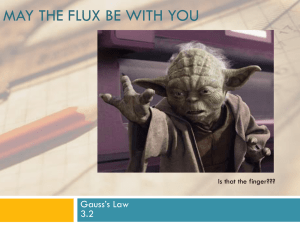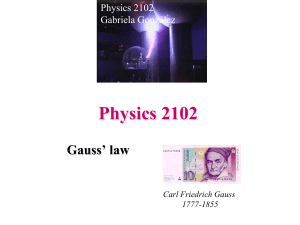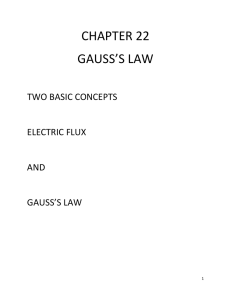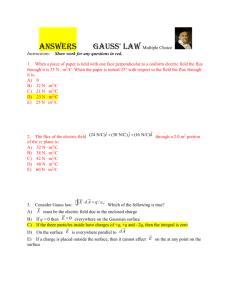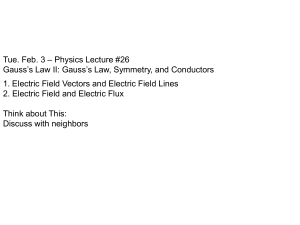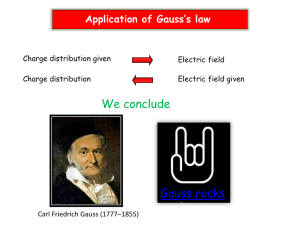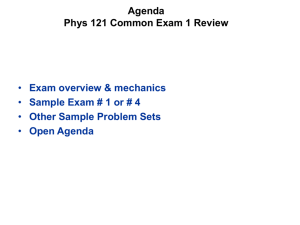8.022 (E&M) - Lecture 2
advertisement
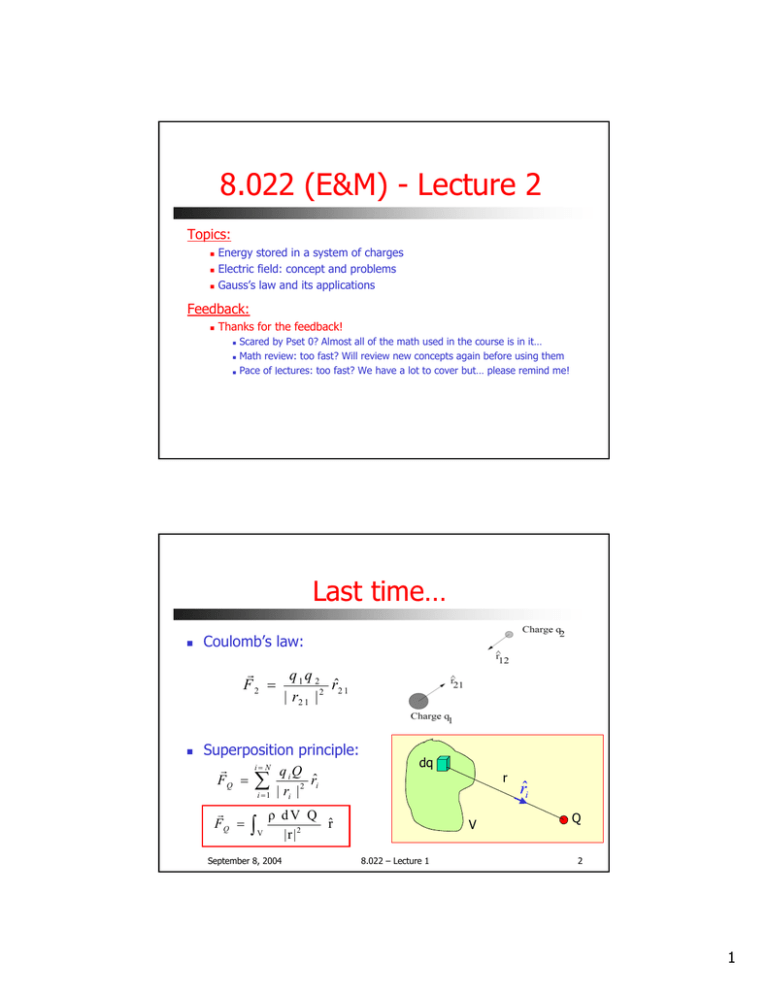
8.022 (E&M) - Lecture 2 Topics: Energy stored in a system of charges Electric field: concept and problems Gauss’s law and its applications Feedback: Thanks for the feedback! Scared by Pset 0? Almost all of the math used in the course is in it… Math review: too fast? Will review new concepts again before using them Pace of lectures: too fast? We have a lot to cover but… please remind me! Last time… Coulomb’s law: q1q 2 rˆ2 1 | r2 1 | 2 F2 = Superposition principle: i= N FQ = ∑ FQ = ∫ i =1 V qiQ rˆi | ri | 2 qdq 2 q3 8.022 – Lecture 1 qN rQ rˆi qi ρ dV Q r̂ |r| 2 September 8, 2004 q1 V rˆi q5 Q 2 1 Energy associated with FCoulomb y q Q r2 x r1 How much work do I have to do to move q from r1 to r2? September 8, 2004 8.022 – Lecture 1 3 Work done to move charges How much work do I have to do to move q from r1 to r2? W = ∫ FI • ds where FI = − FCoulomb = − Assuming radial path: W ( r1 → r2 ) = ∫ FI • ds = − ∫ r2 r1 Qqrˆ . r2 ds q Qqrˆ Qq Qq − idrˆ = 2 r r2 r1 Q Does this result depend on the path chosen? r2 r1 No! You can decompose any path in segments // to the radial direction and segments |_ to it. Since the component on the |_ is null the result does not change. September 8, 2004 8.022 – Lecture 1 4 2 Corollaries The work performed to move a charge between P1 and P2 is the same independently of the path chosen W12 = ∫ F • ds =∫ F • ds =∫ F • ds Path1 Path 2 Path 3 y P2 1 2 3 P1 x The work to move a charge on a close path is zero: W11 = ∫ F • ds = 0 Any In other words: the electrostatic force is conservative! This8, will the–concept September 2004allow us to introduce 8.022 Lecture 1of potential (next week) 5 Energy of a system of charges How much work does it take to assemble a certain configuration of charges? y q2 q3 q1 x P1 W (Q) = ∫ F • ds = 0 no other charges: F=0 ∞ q1q2 r12 qq qq q q = W1+ 2 + W1+3 + W2+3 = 1 2 + 1 3 + 2 3 r12 r13 r23 W1+ 2 = ∫ FI • ds = W1+ 2+3 September 8, 2004 8.022 – Lecture 1 Energy stored by N charges: U= 1 i=N ∑ 2 i =1 j=N qi q j j =1 j ≠i rij ∑ 6 3 The electric field Q: what is the best way of describing the effect of charges? FES 1 charge in the Universe 2 charges in the Universe Fq = q Q qQ rˆ | r |2 But: the force F depends on the test charge q… define a quantity that describes the effect of the charge Q on the surroundings: Electric Field E = September 8, 2004 Fq q = Q rˆ | r |2 Units: dynes/e.s.u 7 8.022 – Lecture 1 Electric field lines Visualize the direction and strength of the Electric Field: Direction: // to E, pointing towards – and away from + Magnitude: the denser the lines, the stronger the field. Demo Sink Faucet + - Properties: Field lines never cross (if so, that’s where E=0) They are orthogonal to equipotential surfaces (will see this later). September 8, 2004 8.022 – Lecture 1 8 4 Electric field of a ring of charge Problem: Calculate the electric field created by a uniformly charged ring on its axis Special case: center of the ring General case: any point P on the axis P z R Answers: • Center of the ring: E=0 by symmetry Qz • General case: E = zˆ 3 (R 2 + z2 )2 September 8, 2004 9 8.022 – Lecture 1 Electric field of disk of charge Problem: Find the electric field created by a disk of charges on the axis of the disk Trick: a disk is the sum of an infinite number of infinitely thin concentric rings. And we know Ering… P z R r (creative recycling is fair game in physics) September 8, 2004 8.022 – Lecture 1 10 5 E of disk of charge (cont.) Electric field of a ring of radius r: zQ E rin g ( r ) = (r 2 + z 2 ) 3 2 P zˆ z If charge is uniformly spread: d q = σ d a = 2π rσ d r R Electric field created by the ring is: dE = zσ 2 π r d r 3 zˆ (r 2 + z 2 ) 2 Integrating on r: 0 R: r=R E = ∫ r=R ∫ dE = r =0 r =0 r ⎛ 1 zˆ = 2πσ zzˆ ⎜ − 3 |z| 2 2 2 ⎝ (r + z ) zσ 2π dr September 8, 2004 ⎞ ⎟ 2 2 R +z ⎠ 1 8.022 – Lecture 1 11 Special case 1: R infinity ⎛ 1 − For finite R: E = 2πσ zzˆ ⎜ ⎝|z| ⎞ ⎟ R +z ⎠ 1 2 2 P What if R infinity? E.g. what if R>>z? Since lim R→∞ 1 R2 + z2 =0 z R E = 2πσ zˆ Conclusion: Electric Field created by an infinite conductive plane: Direction: perpendicular to the plane (+/- z) Magnitude: 2πσ (constant!) September 8, 2004 8.022 – Lecture 1 12 6 Special case 2: h>>R ⎛ 1 − For finite R: E = 2πσ zzˆ ⎜ ⎝|z| P ⎞ ⎟ 2 2 R +z ⎠ 1 z What happens when h>>R? R Physicist’s approach: The disk will look like a point charge with Q=σπr2 E=Q/z2 Mathematician's approach: Calculate from the previous result for z>>R (Taylor expansion): 2 −1 / 2 ⎞ ⎛ ⎞ 1 ⎜⎛ ⎛R⎞ ⎞ ⎟ 1 − ⎜1 + ⎜ ⎟ ⎟ ⎟ = 2πσ zzˆ ⎜ ⎟ ⎟ z⎜ z ⎝ ⎠ R2 + z2 ⎠ ⎝ ⎠ ⎝ ⎠ 2 2 ⎛ Q 1⎛R⎞ ⎞ ⎛R⎞ ~ 2 πσ zˆ ⎜ 1 − (1 − ⎜ ⎟ ) ⎟ = πσ zˆ ⎜ ⎟ = 2 zˆ ⎜ ⎟ 2 ⎝ z ⎠ ⎠ 8.022 –⎝Lecture z ⎠ 1 z September ⎝8, 2004 ⎛ 1 E = 2 πσ zzˆ ⎜ − ⎝|z| 1 13 The concept of flux v n̂ Consider the flow of water in a river The water velocity is described by v ( x, y, z ) ≡ vx xˆ + v y yˆ + vz zˆ ≡ (vx , v y , vz ) Immerse a squared wire loop of area A in the water (surface S) Define the loop area vector as A ≡ Anˆ Q: how much water will flow through the loop? E.g.: What is the “flux of the velocity” through the surface S? September 8, 2004 8.022 – Lecture 1 14 7 What is the flux of the velocity? It depends on how the loop is oriented w.r.t. the water… Assuming constant velocity and plane loop: . 1 ) if A ⊥ v → Φ v = 0; . 2 ) if A v → Φ v = vA ; . 3 ) if A v = θ → Φ v = vA co s θ = v i A . n̂ v n̂ v n̂ v θ General case (definition of flux): Φv = September 8, 2004 ∫ S v idA 8.022 – Lecture 1 15 F.A.Q.: what is the direction of dA? Defined unambiguously only for a 3d surface: At any point in space, dA is perpendicular to the surface It points towards the “outside” of the surface Examples: . . . n̂ Intuitively: “dA is oriented in such a way that if we have a hose inside the surface the flux through the surface will be positive” September 8, 2004 8.022 – Lecture 1 16 8 Flux of Electric Field Definition: ΦE ≡ Φ = ∫ S E idA Example: uniform electric field + flat surface Calculate the flux: E Φ = ∫ E idA = E i A = EA cos θ θ S Interpretation: Represent E using field lines: ΦE is proportional to Nfield lines that go through the loop NB: this interpretation is valid for any electric field and/or surface! September 8, 2004 8.022 – Lecture 1 17 ΦE through closed (3d) surface Consider the total flux of E through a cylinder: Φ tot = Φ1 + Φ 2 + Φ 3 E 1 Calculate Φ1, Φ2, Φ3 dA dA 2 3 Cylinder axis is // to field lines Φ2=0 because E ⊥ nˆ | Φ1|=|Φ3| but opposite sign since Φ = ∫ E idA = EA cos θ S The total flux through the cylinder is zero! September 8, 2004 8.022 – Lecture 1 18 9 ΦE through closed empty surface Q1: Is this a coincidence due to shape/orientation of the cylinder? Clue: Think about interpretation of ΦE: proportional # of field lines through the surface… Answer: No: all field lines that get into the surface have to come out! Conclusion: The electric flux through a closed surface that does not contain charges is zero. September 8, 2004 8.022 – Lecture 1 19 ΦE through surface containing Q Q1: What if the surface contains charges? Clue: Think about interpretation of ΦE: the lines will either originate in the surface (positive flux) or terminate inside the surface (negative flux) Sink Faucet + - Conclusion: The electric flux through a closed surface that does contain a net charge is non zero. September 8, 2004 8.022 – Lecture 1 20 10 Simple example: ΦE of charge at center of sphere +Q Problem: Calculate ΦE for point charge +Q at the center of a sphere of radius R Solution: .E // d A e v e ryw h e re o n th e sp h e re .P o in t c h a rg e a t d is ta n c e R : E = Q2 R Φ = ∫ S E idA = ∫ S Q Q dA = 2 2 R R September 8, 2004 ∫ S dA = rˆ Q 4π R 2 = 4π Q R2 8.022 – Lecture 1 21 ΦE through a generic surface What if the surface is not spherical S? Impossible integral? Use intuition and interpretation of flux! Version 1: S +Q Consider the sphere S1 Field lines are always continuous S1 ΦS1=ΦS=4πQ Version 2: Purcell 1.10 or next lecture Conclusion: The electric flux Φ through any closed surface S containing a net charge Q is proportional to the charge enclosed: Φ= September 8, 2004 ∫ S E i dA = 4π Qenc 8.022 – Lecture 1 Gauss’s law 22 11 Thoughts on Gauss’s law Φ= ∫ S E idA = 4π Qencl (Gauss's law in integral form) Why is Gauss’s law so important? Because it relates the electric field E with its sources Q Given Q distribution find E (integral form) Given E find Q (differential form, next week) Is Gauss’s law always true? Yes, no matter what E or what S, the flux is always = 4πQ Is Gauss’s law always useful? No, it’s useful only when the problem has symmetries September 8, 2004 8.022 – Lecture 1 23 Applications of Gauss’s law: Electric field of spherical distribution of charges Problem: Calculate the electric field (everywhere in space) due to a spherical distribution of positive charges or radius R. y (NB: solid sphere with volume charge density ρ) Approach #1 (mathematician) • I know the E due to a point charge dq: dE=dq/r2 • I know how to integrate • Solve the integral inside and outside the sphere (e.g. r<R and r>R) r '= r ∫ r '= 0 r '= r dE = dq = r' r '= 0 ∫ r '= r ∫ r '= 0 ρ dV r '2 = ∫ dθ ∫ dφ r '= r ∫ r '= 0 ρ r '2 r ''2 + R x sinθ d θ d φ Comment: correct but usually heavy on math! Approach #2 (physicist) • Why would I ever solve an integral is somebody (Gauss) already did it for me? • Just use Gauss’s theorem… Comment: correct, much much less time consuming! September 8, 2004 8.022 – Lecture 1 24 12 Applications of Gauss’s law: Electric field of spherical distribution of charges Physicist’s solution: 1) Outside the sphere (r>R) Apply Gauss on a sphere S1 of radius r: Φ = ∫ S1 S2 r E i dA = 4π Q enclosed + S ym m etry: E is constant on S1 and 2 ∫ E i dA = E 4π r = 4π Q to dA . R → E = For r>R, sphere looks like a point charge! Q r2 S1 r S1 2) Inside the sphere (r<R) Apply Gauss on a sphere S2 of radius r: A g ain : Φ = ∫ S2 ∫ S2 E i d A = 4 π Q en clo se d ; sym m e try: E is c o n s ta n t o n S 2 a n d E i d A = E 4π r 2 ; Q en c = September 8, 2004 ∫ ρ dV =ρ 4 π r3 → 3 E = to d A . 4 πρ r 3 8.022 – Lecture 1 25 Do I get full credit for this solution? Did I answer the question completely? No! I was asked to determine the electric field. The electric field is a vector magnitude and direction r How to get the E direction? + Look at the symmetry of the problem: Spherical symmetry C om plete solution: Q E = 2 rˆ for r>R r 4 E = πρ rrˆ for r<R 3 September 8, 2004 R E must point radially S1 r E R 8.022 – Lecture 1 r 26 13 Another application of Gauss’s law: Electric field of spherical shell Problem: Calculate the electric field (everywhere in space) due to a positively charged spherical shell or radius R (surface charge density σ) Physicist’s solution:apply Gauss 1) Outside the sphere (r>R) Apply Gauss on a sphere S1 of radius r: Φ = ∫ S1 + E i dA = 4π Q enclosed Sym m etry: E is constant on S1 and ∫ S1 → S2 R to dA. S1 E i dA = E 4π r 2 = 4π Q encl = 4π σ ( 4π R 2 ) E = 4πσ R 2 Q rˆ = 2 rˆ r2 r sam e as point charge! 1) Inside the sphere (r<R) NB: spherical symmetry E is radial Apply Gauss on a sphere S2 of radius r. But sphere is hollow September 8, 2004 Qenclosed=0 E=0 8.022 – Lecture 1 27 Still another application of Gauss’s law: Electric field of infinite sheet of charge Problem: Calculate the electric field at a distance z from a positively charged infinite plane of surface charge density σ Again apply Gauss Trick #1: choose the right Gaussian surface! Look at the symmetry of the problem Choose a cylinder of area A and height +/- z Trick #2: apply Gauss’s theorem Φtot = Φside + Φtop + Φbottom Symmetry: E // z axis Φside=0 and Φtop = Φbottom Φ = ∫ ∫ cylinder cylinder z E E i dA = 4π Q enclosed E i dA = 2 ∫ EdA = 2 EA = 4π (σ A ) September 8, 2004 top 8.022 – Lecture 1 → E = 2πσ zˆ 28 14 Checklist for solving 8.022 problems Read the problem (I am not joking!) Look at the symmetries before choosing the best coordinate system Look at the symmetries again and find out what cancels what and the direction of the vectors involved Look for a way to avoid all complicated integration Remember physicists are lazy: complicated integral somewhere or there is an easier way out! you screwed up Turn the math crank… Write down the complete solution (magnitudes and directions for all the different regions) Box the solution: your graders will love you! If you encounter expansions: Find your expansion coefficient (x<<1) and “massage” the result until you get something that looks like (1+x)N, (1-x)N, or ln(1+x) or ex Don’t stop the expansion too early: Taylor expansions are more than limits… September 8, 2004 8.022 – Lecture 1 29 Summary and outlook What have we learned so far: Energy of a system of charges Concept of electric field E To describe the effect of charges independently from the test charge Gauss’s theorem in integral form: Φ. = ∫ S E i dA = 4π Qencl Useful to derive E from charge distribution with easy calculations Next time: Derive Gauss’s theorem in a more rigorous way See Purcell 1.10 if you cannot wait… Gauss’s law in differential form … with some more intro to vector calculus… ☺ Useful to derive charge distribution given the electric fields Energy associated with an electric field September 8, 2004 8.022 – Lecture 1 30 15

